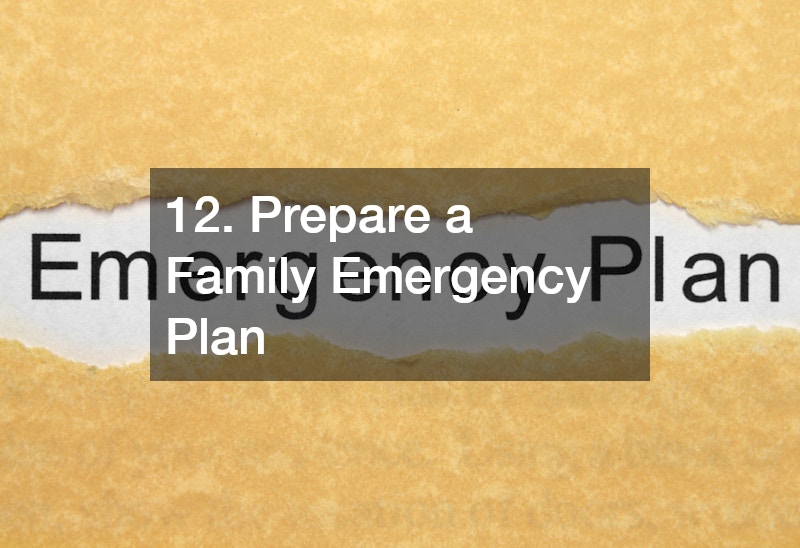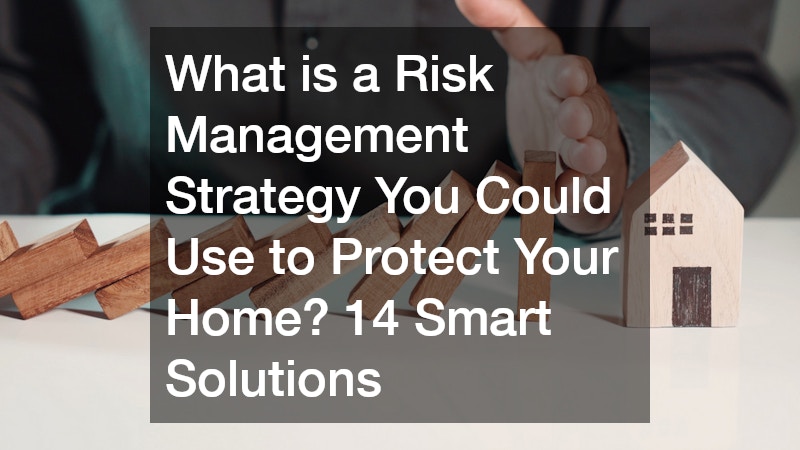
Your home is likely one of your most significant investments—not just financially, but emotionally, too. That’s why protecting it from various risks like natural disasters, theft, accidents, and even financial losses is crucial. This is where risk management strategies for homeowners come into play. These strategies help you identify potential hazards and take proactive steps to prevent, mitigate, or recover from them.
From installing security systems to reviewing your insurance coverage and creating disaster response plans, every measure you take enhances your peace of mind. In this article, we’ll explore 14 smart solutions that offer a comprehensive approach to protecting your home. Whether you’re a first-time homeowner or have years of experience maintaining a property, these actionable tips will help safeguard your sanctuary.
1. Why Risk Management Matters for Homeowners
Risk management isn’t just for businesses. For homeowners, it’s a structured approach to identifying, evaluating, and addressing the threats that could impact the safety, value, and functionality of your home.
What can go wrong?
- Natural disasters: floods, hurricanes, earthquakes
- Man-made risks: theft, fire, vandalism
- Structural issues: plumbing failure, roof damage
- Financial loss: underinsurance, liability claims
Risk management strategies reduce potential damages and help you recover more quickly if something goes wrong. They also make you a more informed and responsible homeowner, possibly lowering insurance premiums or increasing property value. In short, it’s about being proactive, not reactive.
2. Get the Right Insurance Coverage
Are You Covered Where It Counts?
Home insurance forms a critical layer of defense in any homeowner’s risk management strategy. But having a policy isn’t enough—you need to make sure it’s tailored to your actual needs. Many standard policies have limitations or exclusions that leave homeowners exposed.
Key areas to review:
- Structure coverage: Shields the physical home—including walls, roof, and built-in systems—from damage.
- Contents protection: Safeguards valuables such as gadgets, furniture, and personal belongings.
- Liability insurance: Helps cover legal fees and damages if someone is injured on your property.
- Temporary living coverage: Assists with hotel stays and other costs if you’re displaced after a covered incident.
- Special hazard insurance: Floods and earthquakes typically require add-on policies, as they’re not part of standard coverage.
Pro tip: Revisit your policy each year, especially after significant upgrades or large purchases. Adding smart devices, renovating rooms, or increasing property value can change your insurance needs. A conversation with your insurance provider can ensure you’re not left underinsured.
3. Install a Modern Home Security System

Can Technology Keep You Safer?
Break-ins and theft are a major concern for many homeowners, and the solution lies in modern, integrated home security systems.
What to consider installing:
- Smart cameras (indoor/outdoor)
- Motion detectors
- Smart locks
- Door/window sensors
- 24/7 monitoring services
These systems not only deter criminals but also provide documentation in case of insurance claims. Many systems also integrate with mobile apps, allowing you to monitor your home remotely.
Bonus: Some insurers offer discounts for homes with approved security systems, reducing your premium while increasing safety.
4. Invest in Fire and Carbon Monoxide Protection
What’s the Real Risk of Fire or CO Poisoning?
Fires and carbon monoxide (CO) leaks can be deadly. Unfortunately, they’re also more common than people think. According to the U.S. Fire Administration, there are over 350,000 house fires annually in the U.S.
Protection strategies:
- Install smoke detectors in every bedroom, kitchen, and hallway.
- Use CO detectors near sleeping areas and any fuel-burning appliance.
- Keep fire extinguishers in key locations: kitchen, garage, and near fireplaces.
- Schedule annual HVAC and chimney inspections.
Maintenance tip: Test alarms monthly and replace batteries twice a year. Replace units every 10 years.
5. Secure Your Home from Natural Disasters
Is Your Home Disaster-Ready?
Natural disasters are unpredictable, but you can minimize their impact with proper preparation. Tailor your strategy to your region’s risks.
For different disaster types:
- Earthquakes: Bolt your home’s foundation, anchor heavy furniture, and use flexible pipe fittings.
- Floods: Install sump pumps, elevate HVAC units, and use water-resistant materials in basements.
- Hurricanes: Add storm shutters, reinforce garage doors, and secure loose outdoor items.
- Wildfires: Create defensible space around the home, use fire-resistant landscaping, and install ember-resistant vents.
You should also create an emergency plan and stock up on essentials like water, non-perishables, flashlights, and batteries.
6. Regular Home Maintenance: The First Line of Defense
Can Routine Checks Prevent Major Issues?
Yes—and it’s often overlooked. Many costly repairs stem from minor issues that could’ve been addressed earlier.
Maintenance checklist:
- Roof: Inspect for leaks and damage annually.
- Gutters: Clean twice a year to prevent water damage.
- HVAC system: Service before the summer and winter seasons.
- Plumbing: Check for leaks under sinks, around toilets, and near water heaters.
- Foundation: Look for cracks or signs of moisture.
Use a calendar or home management app to schedule seasonal tasks. Preventive maintenance reduces the risk of bigger (and costlier) problems.
7. Smart Landscaping to Minimize Risk
Can Your Garden Keep Your Home Safer?
Yes. Landscaping is more than curb appeal—it’s also a smart way to manage risk. Improper landscaping can contribute to flooding, foundation issues, or even make your home more vulnerable to wildfires and theft.
Smart landscaping tips:
- Trim trees and shrubs: Avoid falling limbs and improve visibility.
- Slope soil away from the foundation: Helps prevent basement flooding.
- Install French drains: Manages excess rainwater.
- Use gravel or rock borders: Creates firebreaks in wildfire-prone zones.
- Avoid tall hedges near entryways: Reduces hiding spots for burglars.
Landscaping with safety in mind is both attractive and functional.
8. What Is a Risk Management Strategy You Could Use to Protect Your Home?
This question lies at the heart of proactive homeownership. A risk management strategy for your home involves evaluating threats, applying safeguards, and reviewing them regularly.
A 3-Step Framework:
- Identify Risks:
- What could go wrong? (Fire, flood, break-in, lawsuit)
- Assess Impact:
- What would it cost financially or emotionally?
- Take Action:
- Mitigate the risk through insurance, maintenance, or technology.
A comprehensive approach also involves documenting valuables, creating home inventories, and updating legal documents like home warranties or emergency contact lists.
The more you plan in advance, the less you panic when something goes wrong.
9. Create a Digital Home Inventory
What Would You Do After a Major Loss?
If your home is burglarized or damaged in a disaster, your insurance claim will go more smoothly if you have a digital home inventory. It’s a record of all your belongings with descriptions, serial numbers, and receipts.
How to create one:
- Walk room-by-room and document everything using photos or video.
- Store info in cloud-based tools like Google Drive, Evernote, or specialized apps.
- Update annually or when you make big purchases.
This strategy speeds up recovery and ensures you receive proper compensation from your insurer.
10. Consider Legal and Financial Protections
What If Someone Gets Hurt on Your Property?
Liability is a real concern. Legal and financial protections can shield you from unexpected lawsuits and costs.
Protective strategies:
- Umbrella insurance: Provides extra liability coverage beyond your homeowners policy.
- Install railings and non-slip surfaces: Especially for stairs, pools, and walkways.
- Secure pets: A dog bite incident can lead to legal issues.
- Post warning signs: “Beware of Dog” or “Wet Floor” may limit liability.
Also, consider setting up a living trust or LLC for ownership in certain cases (like rental properties) to protect assets.
11. Protect Against Cyber Risks in Smart Homes
Is Your Smart Home Secure from Hackers?
With the rise of smart devices—from security cameras to thermostats—homes are more connected than ever. But increased connectivity also brings greater cyber risk. Hackers can exploit weak networks, putting your privacy, data, and even physical safety at risk.
Steps to reduce cyber threats:
- Use strong, unique passwords for each smart device.
- Keep firmware and software up to date.
- Install a secure, firewall-enabled router.
- Consider a VPN for your home network.
- Regularly audit your smart home setup for unused or vulnerable devices.
Cybersecurity isn’t just for businesses—it’s vital for every connected household.
12. Prepare a Family Emergency Plan

Do You and Your Family Know What to Do in a Crisis?
An emergency plan ensures everyone in your household knows what to do during a disaster, minimizing confusion and panic. Whether it’s a fire, earthquake, or home intrusion, clarity saves lives.
What your plan should include:
- Clearly marked and practiced escape routes.
- A designated meeting spot outside the home.
- Emergency contact numbers written down and saved in phones.
- A go-bag with essentials: water, food, medications, IDs, flashlights.
- Roles assigned for pets, elderly family members, and kids.
Practice the plan at least twice a year so it becomes second nature.
13. Use Financial Planning as a Protective Strategy
Is Your Budget Ready for the Unexpected?
Risk management isn’t only about physical threats—it also involves preparing for financial shocks. A solid financial plan helps you weather emergencies without going into debt or sacrificing home safety.
Smart financial safeguards include:
- Building an emergency fund (3–6 months of expenses).
- Budgeting for annual home maintenance costs.
- Keeping records of receipts, warranties, and insurance policies.
- Creating a financial inventory of your assets.
- Reviewing your mortgage terms and life insurance to ensure stability.
When your finances are in order, recovering from home-related emergencies becomes far less stressful.
14. Monitor Environmental Risks Near Your Property
What Hazards Lurk Around Your Neighborhood?
Location-based risks can increase your home’s vulnerability. Understanding your environment helps you take preventive action, even before buying a home.
Things to investigate or monitor:
- Flood zones: Use FEMA or local maps to see if you’re at risk.
- Proximity to industrial sites: Can affect air/water quality.
- Nearby wildfire-prone areas or dense forests.
- Weather patterns: Does your region face frequent storms, snow, or drought?
- Crime statistics: Check for local break-in or vandalism trends.
Knowledge of your surroundings helps you plan smarter and invest in the right protective upgrades.
Conclusion: Home Safety Starts with Smart Planning
There’s no such thing as a completely risk-free home. But there is such a thing as a well-protected one. By combining insurance, technology, legal safeguards, and proactive maintenance, you can reduce threats to your home and increase your confidence in handling the unexpected.
Start small: pick one strategy from this list and implement it this month. Over time, layer your protections. Homeownership doesn’t have to be a gamble—it can be a well-managed responsibility.




